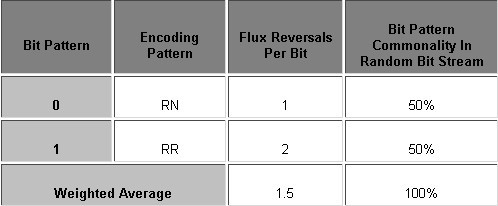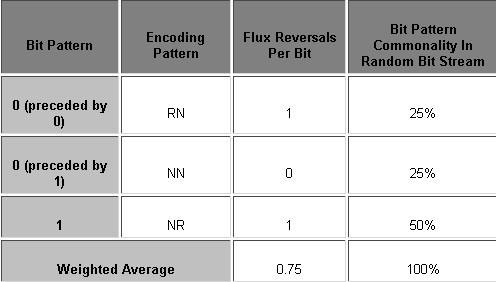Frequency Modulation (FM)
Note: This has nothing whatever to do with FM radio, of course, except for a similarity in the concept of how the data is encoded.
The first common encoding system for recording digital data on magnetic media was frequency modulation, of course abbreviated FM. This is a simple scheme, where a one is recorded as two consecutive flux reversals, and a zero is recorded as a flux reversal followed by no flux reversal. This can also be thought of as follows: a flux reversal is made at the start of each bit to represent the clock, and then an additional reversal is added in the middle of each bit for a one, while the additional reversal is omitted for a zero.
This table shows the encoding pattern for FM (where I have designated “R” to represent a flux reversal and “N” to represent no flux reversal). The average number of flux reversals per bit on a random bit stream pattern is 1.5. The best case (all zeroes) would be 1, the worst case (all ones) would be 2:
The name “frequency modulation” comes from the fact that the number of reversals is doubled for ones compared to that for zeros. This can be seen in the patterns that are created if you look at the encoding pattern of a stream of ones or zeros. A byte of zeroes would be encoded as “RNRNRNRNRNRNRNRN”, while a byte of all ones would be “RRRRRRRRRRRRRRRR”. As you can see, the ones have double the frequency of reversals compared to the zeros; hence frequency modulation (meaning, changing frequency based on data value).
FM encoding write waveform for the byte “10001111”. Each bit cell is depicted as a blue rectangle with a pink line representing the position where a reversal is placed, if necessary, in the middle of the cell.
The problem with FM is that it is very wasteful: each bit requires two flux reversal positions, with a flux reversal being added for clocking every bit. Compared to more advanced encoding methods that try to reduce the number of clocking reversals, FM requires double (or more) the number of reversals for the same amount of data. This method was used on the earliest floppy disk drives, the immediate ancestors of those used in PCs. If you remember using “single density” floppy disks in the late 1970s or early 1980s, that designation commonly refers to magnetic storage using FM encoding. FM was actually made obsolete by MFM before the IBM PC was introduced, but it provides the basis for understanding MFM.
Modified Frequency Modulation (MFM)
A refinement of the FM encoding method is modified frequency modulation, or MFM. MFM improves on FM by reducing the number of flux reversals inserted just for the clock. Instead of inserting a clock reversal at the start of every bit, one is inserted only between consecutive zeros. When a 1 is involved there is already a reversal (in the middle of the bit) so additional clocking reversals are not needed. When a zero is preceded by a 1, we similarly know there was recently a reversal and another is not needed. Only long strings of zeros have to be “broken up” by adding clocking reversals.
This table shows the encoding pattern for MFM (where I have designated “R” to represent a flux reversal and “N” to represent no flux reversal). The average number of flux reversals per bit on a random bit stream pattern is 0.75. The best case (a repeating pattern of ones and zeros, “101010…”) would be 0.25, the worst case (all ones or all zeros) would be 1:
Since the average number of reversals per bit is half that of FM, the clock frequency of the encoding pattern can be doubled, allowing for approximately double the storage capacity of FM for the same areal density. The only cost is somewhat increased complexity in the encoding and decoding circuits, since the algorithm is a bit more complicated. However, this isn’t a big deal for controller designers, and is a small price to pay for doubling capacity.
FM and MFM encoding write waveform for the byte “10001111”. As you can see, MFM encodes the same data in half as much space, by using half as many flux reversals per bit of data.MFM encoding was used on the earliest hard disks, and also on floppy disks. Since the MFM method about doubles the capacity of floppy disks compared to earlier FM ones, these disks were called “double density”. In fact, MFM is still the standard that is used for floppy disks today. For hard disks it was replaced by the more efficient RLL methods. This did not happen for floppy disks, presumably because the need for more efficiency was not nearly so great, compared to the need for backward compatibility with existing media.
Data recovery Salon welcomes your comments and share with us your ideas, suggestions and experience. Data recovery salon is dedicated in sharing the most useful data recovery information with our users and only if you are good at data recovery or related knowledge, please kindly drop us an email and we will publish your article here. We need to make data recovery Salon to be the most professional and free data recovery E-book online.
World’s Top Data Recovery Hardware Tools

Easy to use at good price
Recover SATA, IDE, External HDDs, NVME SSDs, etc Order Now here
POTABLE DEVICE & NVME SSD RECOVERY TOOL

Recover USB Device and NVME SSDs at high speed! Read Details here.
DFL-PCIE DATA RECOVERY RECHARGE

Best data recovery hardware tool to start a data recovery business, read details here
RECOVER SCRATCHED HDDS

Recover lost data from scratched hard drives, read details here.
SURFACE PRO. RECOVERY
BEST HEAD REPLACEMENT TOOLS

The most cost-effective head replacement tools for Seagate, WD, Samsung, Hitachi, Toshiba, Fujitsu





